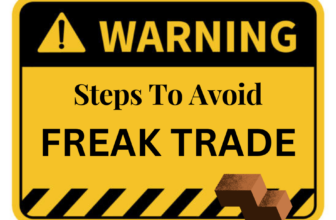Intraday trading is a type of stock market trading where traders buy and sell stocks within one day. It is a popular form of trading as it allows traders to make quick profits from stock market movements. As intraday trading is a risky form of trading, it is important to have a trading plan and know the top rules for intraday traders.
1. Start with Small Capital:
Intraday trading requires traders to invest a large amount of capital to make profits. However, it is important to start with small capital and gain experience before investing a large amount of capital. This will help reduce losses and increase profits. As you gain experience you will have confidence in your trades.
2. Use Stop Loss:
Stop loss is a predetermined limit that allows traders to limit their losses. It is a must to use stop loss as it helps traders close their positions at a predetermined price, thereby limiting their losses. There are times when the system hits your stop loss and then bounces back into profit but not keeping a stop loss can give you a huge loss in some scenarios hence it’s always advisable to keep a decent stop loss.
3. Do Not Over Trade:
Over trading is when a trader is buying and selling too many stocks in a single session. This can lead to losses if the market does not move in the direction of the trader’s expectations. It is important to limit the number of trades and stick to the plan.
4. Follow the Trend:
Intraday trading requires traders to buy and sell stocks according to the market trend. Following the trend will help traders identify profitable trades. It is also important to stick to the trend by not trading against the market as this may lead to losses.
5. Diversify:
Diversification is an important factor in intraday trading as it reduces the risk of losses. Traders should trade in different stocks and sectors to reduce the risk of losses.
6. Use Technical Analysis:
Technical analysis is a method of analysis used by traders to predict the future movements of the stock market. Technical analysis helps traders identify the trend and make informed decisions.
7. Stay Updated:
Staying updated with the market news and events is important as it helps traders to make informed decisions. It is important to keep track of the stock market news and movements.
How To Select Stocks for Intraday?
Intraday trading is a popular form of stock market trading where traders buy and sell stocks within one day. It is a risky form of trading, but it can be profitable if done correctly. To be successful in intraday trading, it is important to select the right stocks. Here are the steps to help you select stocks for intraday:
1. Identify Your Strategy:
The first step is to identify your trading strategy. This will help you narrow down the list of stocks to select from. Different strategies include trading the trend, buying and holding, scalping, etc.
2. Use Screeners:
There are many screener websites. You can use the screener website to zero down the handful of stocks that will be your intraday stocks.
3. Look for Liquidity:
Liquidity is important for intraday trading as it allows traders to enter and exit trades quickly. It is important to look for stocks with high liquidity as this will ensure you are able to enter and exit trades quickly.
4. Use Chart Patterns:
It is important to use chart patterns to identify stocks that are likely to move in the direction of the trend. Different chart patterns include trend lines, support, and resistance levels, etc.
5. Choose Stocks from Nifty and Bank Nifty:
Nifty and Bank Nifty are two popular stock indices in India. These indices contain stocks from different sectors and industries. It is important to select stocks from these indices as they are more likely to move in the direction of the trend.
Top Indicators for Intraday Trading
To be successful in intraday trading, it is important to use indicators along with price action to gain insights into the market. Here are the top indicators for intraday trading:
1. Moving Average:
Moving average is an indicator used to identify the trend direction. It is calculated by taking the average of the closing prices of a stock over a certain period of time. When the stock price is above the moving average, it indicates an uptrend and when it is below the moving average, it indicates a downtrend. The most widely used Moving Averages are 7, 13, 21, 50, 100, 200.
2. Relative Strength Index (RSI):
RSI is an indicator used to identify the momentum of a stock. It compares the average gains and losses of a stock over a certain period of time. A value above 70 indicates that the stock is overbought and a value below 30 indicates that the stock is oversold.
3. Bollinger Bands:
Bollinger bands are a type of trading indicator used to identify the volatility of a stock. They consist of three lines: an upper line, a middle line, and a lower line. When the stock price is between the upper and lower lines, it indicates that the stock is in a range-bound market.
4. Stochastic Oscillator:
The stochastic oscillator is an indicator used to identify the momentum of a stock. It compares the current closing price of a stock with its previous closing prices. When the current closing price is above the previous closing price, it indicates an uptrend and when it is below the previous closing price, it indicates a downtrend.
In conclusion, intraday trading is a risky form of trading, but it can be profitable if done correctly. To be successful, it is important to have a trading plan and know the top rules for intraday traders. Furthermore, it is important to select the right stocks and use indicators along with price action to gain insights into the market. By following these steps, traders can increase their chances of making profits in intraday trading.







